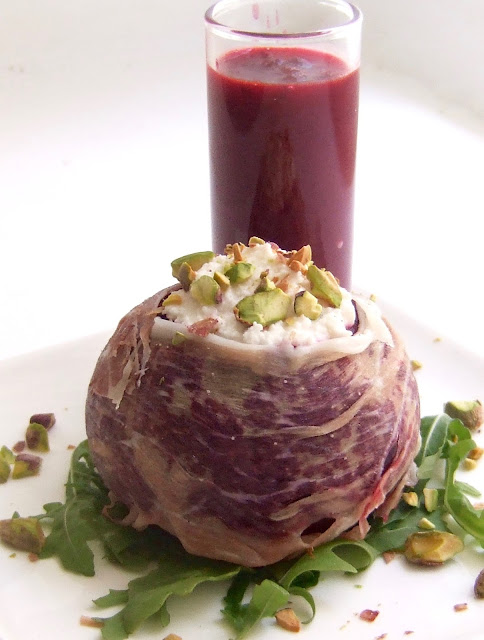Nascido por trás do véu - Born behind the veil
stuffed roasted beetroot with beetroot gazpacho shot
In my latest culinary beetroot adventure I have wrapped a caul of parma ham around it. The birth caul or veil is a full face mask which may be sometimes found covering the face of a child at birth. Such births are quite rare, something of a phenomenom, and they hold special significance for the child born in such a manner. There are many stories and myths about the caul, many of them erroneous.The correct name for those who are born with a caul is a Caulbearer. Such people are often referred to as being born behind the veil, as the caul is also referred to as the veil in many cultures, due to it being a face covering or mask.
For those new to the ingredient, caul fat is the thin, fatty membrane that surrounds the stomachs of ruminants like cows, pigs, and sheep. It's a thinner-than-paper sheet that has lines of fat running through it in a pattern that sort of looks like it was made by a drunk spider. Although delicate, it's easier to work with than sausage casings, and doesn't come with any of the funky odour of animal intestines.I was lucky enough recently to lay my hands on some extremely thin sliced prosciutto de parma. It was so thin it almost resembled a caul and it inspired me to swaddle it around some roasted beetroot that I was planning to stuff with a three cheese mousse and serve as a starter on the casa rosada dinner menu.
Roast beetroot is a year-round staple here at casa rosada , fantastic for tossing in salads, quick starters, or making into dip sand soups. I roast several at once by wrapping them in foil and tucking them into the oven to cook alongside whatever else I might be cooking. Then the beetroots are ready for whenever they are needed.
Beetroot doesn't have to be roasted, and is actually quite delicious grated and eaten raw. But roasting transforms it from something crunchy into something silky and tender. Though it requires a hot oven, I prefer roasting over boiling or steaming because roasting concentrates the flavours and brings out its sweeter side.
This roasting method works for any kind and any size of beetroot. Pick ones that feel hard in your hand, never soft or squishy. If you have the choice, pick bunches with their big leaves still attached. The greens wilt down beautifully and can be added to stir fries, frittatas, pasta dishes, or anywhere else a little extra green might be welcome.
Once roasted, they will keep refrigerated for up to a week. I keep them in one big container and slice off just what I need for whatever I'm making.
What are your favourite ways to use roasted beets?
Roasted beetroot with a three cheese mousse
wrapped in a caul of presunto de serrano
4 medium sized beetroot
170g requeijao
75g chevre
50g parmesan
1 very thinly slice of presunto serrano per portion
pistachio nuts coarsely chopped
rocket leaves for garnish
Preheat oven to 375 degrees F.
Coat beets lightly with oil.
Wrap beetroots in aluminum foil, place on a baking sheet, and roast in the oven until cooked through, approximately 45 to 60 minutes.
Remove from the oven, let cool for 10 minutes.
While the beetroot are cooling prepare the cheese filling by mixing the three cheeses and whipping them together until you have a mousse like substance.
When cool and ready to serve, make a circular incision in the top and cutting around towards the centre carefully remove a chunk from the centre of the beetroot.continue scooping out more flesh from the cavity and discard or eat it.Carefully fill the cavity with the cheese mixuntil paeking slightly above the level of the top of the beetroot.Now carefully wrap the parma ham tightly around the outside of the beetroot and smooth it flat with your fingers. Place in the centre of a serving plate with some rocket or salad leaves of your choosing and place the stuffed beetroot on top.Sprinkle a dusting of chopped pistachio over the top of the stuffing and around the plate.



Comments
Post a Comment